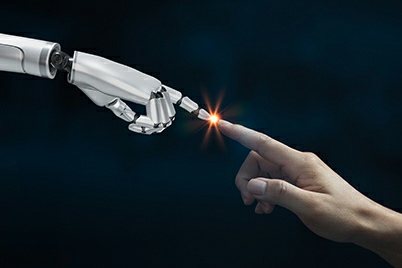

07584-


INTELLIGENT BEHAVIOUR
Is AI playing by the rules?
AI has exploded onto the marketplace over the last year or so, and through a combination of machine learning, written prompts, and user-
It is common belief that copyright in art and imagery is only applicable to that created by the human mind. In fact, a recent court case in the US stated that a piece of art created by AI was not eligible for copyright protection as it had been produced by non-
So how is AI imagery generated?
AI art generators use various algorithms and datasets to obtain, organise and reproduce information or imagery. The most popular of these systems is the “Text-
AI and Copyright Infringement
As stated earlier, in many parts of the world, AI generated artwork cannot be copyrighted, but the images used to create that piece of art will be probably be copyrighted or owned by human artists or contributors. The UK is only one of a handful of countries that protects AI generated works, considering it to be “original human creativity” in that it requires a certain level of skill, labour and creativity to create. However, this legal approach is currently under review. Therefore, across the globe, the chances are, the results of an AI generated image may be subject to copyright infringements.
Getty Images already have a lawsuit against an AI generator that was using unlicensed Getty images to create artwork. Adobe’s AI software – Firefly – is trained to use licensed Adobe Stock imagery which helps to avoid the issue of copyright infringement with its users.
As a rule, you should always assume that AI generated content on the internet, unless it is available on a reputable Image Library, will be subject to copyright infringement, and for that reason should not be used for commercial purposes.
The future of AI and Copyright
AI technology is growing at an ever increasing rate. For the foreseeable future it looks like most countries will adhere to the ruling that AI generated images cannot be copyrighted. As AI is based on the use of data sets, artists, photographers, and Image Libraries may change how they copyright their works to make it harder for the algorithms to obtain their required subject matter.
AI is definitely here to stay, but one key takeaway from this is to always check how these images have been created. Copyright infringement will be a hot topic connected with this technology, so make sure that your AI imagery is licensed through a reputable Image Library.
Please note that the views, thoughts, and opinions expressed in this article belong solely to the author, and not necessarily to any other group or individual. To ensure you are fully compliant with all current legislation, please take legal/professional advice and do not rely solely on the information provided in these articles.

Copyright © 2018-
Terms of Use | Privacy Policy, GDPR & Cookie Policy | Trading Terms





